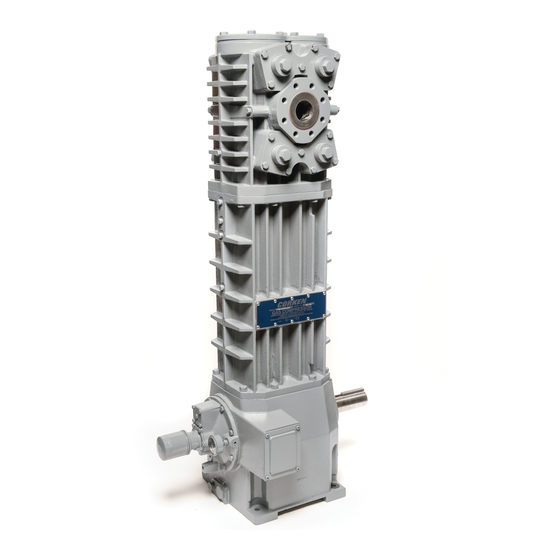Table of Contents
Advertisement
Quick Links
Installation, Operation
& Maintenance Manual
D and T-Style Double-Acting Gas Compressors
Model D891
Compressor Package
Warning: (1) Periodic inspection and maintenance of Corken products is essential. (2) Inspection, maintenance and installation of Corken products must be made
only by experienced, trained and qualified personnel. (3) Maintenance, use and installation of Corken products must comply with Corken instructions, applicable laws
and safety standards (such as NFPA Pamphlet 58 for LP-Gas and ANSI K61.1-1972 for Anhydrous Ammonia). (4) Transfer of toxic, dangerous, flammable or explosive
substances using Corken products is at user's risk and equipment should be operated only by qualified personnel according to applicable laws and safety standards.
Models D791, T791, D891 and T891
Model T891
Compressor
IJ110E
Advertisement
Table of Contents

Summarization of Contents
Features and Benefits
High-efficiency valves
Corken valves offer quiet operation and high durability in oil-free gas applications.
Ductile iron construction
All cylinders and heads are ductile iron for maximum thermal shock endurance.
Self-lubricating PTFE piston rings
Corken provides a variety of piston ring designs for cost-effective, non-lube operation.
Positively locked pistons
Simple piston design allows precise end clearance setting for maximum efficiency.
Self-lubricating piston rod seals
PTFE seals with special fillers ensure no oil carry over and maximize leakage control.
Nitride-coated piston rods
Impregnated nitride coating provides superior corrosion and wear resistance.
Adjustable packing screw
Ensures maximum sealing capacity during the life of the packing (T791/T891 models).
Cast iron crossheads
Durable cast iron crossheads provide superior resistance to corrosion and galling.
Pressure-lubricated crankcase with filter
Self-reversing oil pump ensures proper lubrication; 10-micron filter for bearing life.
Chapter 1-Installing Your Corken Compressor
1.1 Location
Guidelines for compressor placement, ventilation, and clearance requirements.
1.2 Foundation
Recommends a concrete slab foundation and secure anchoring for compressor stability.
1.3 Piping
Stresses proper piping design, flexible connectors, and minimizing pressure drop.
Chapter 1-Installing Your Corken Compressor
1.4 Liquid Trap
Explains the necessity and function of liquid traps for preventing liquid entry into the compressor.
1.5 Driver Installation/Flywheels
Covers driver selection, RPM range, and the importance of the flywheel.
1.6 Crankcase Lubrication
Details filling the crankcase with the appropriate lubricant before startup.
Chapter 1-Installing Your Corken Compressor
1.7 Purging, Padding, Venting and Draining of Distance Pieces
Explains methods for controlling distance piece leakage and maintaining oil-free operation.
Chapter 1-Installing Your Corken Compressor
1.8 Relief Valves
Specifies the requirement for an appropriate relief valve on the compressor discharge side.
1.9 Shutdown/Alarm Devices
Lists common shutdown and alarm devices for protecting the compressor system.
Chapter 2-Starting Up Your Corken Compressor
2.1 Inspection After Extended Storage
Outlines checks for cylinder bore, valve areas, and running gear before startup.
2.2 Flywheel and V-belt Alignment
Details proper flywheel installation, bolt torque, and V-belt tensioning.
2.3 Crankcase Oil Pressure Adjustment
Explains ensuring the oil pump is primed and adjusting oil pressure for smooth operation.
Chapter 2-Starting Up Your Corken Compressor
2.4 Startup Check List
Provides a comprehensive checklist for pre-startup and post-startup verification.
Chapter 4-Routine Service and Repair Procedures
4.1 Valves
Describes how to test, inspect, and replace compressor valves.
Chapter 4-Routine Service and Repair Procedures
4.2 Heads
Discusses cylinder cap and head replacement and causes of damage.
4.3 Piston Rings and Piston Ring Expanders
Details replacing piston rings and expanders for optimal performance.
4.4 Piston Replacement
Provides step-by-step instructions for replacing compressor pistons.
Chapter 4-Routine Service and Repair Procedures
4.5 Piston Rod Packing Adjustment
Explains how to adjust or replace piston rod packing when leakage becomes noticeable.
4.6 Cylinder and Packing Replacement
Covers cylinder replacement and packing procedures for D-style compressors.
Chapter 4-Routine Service and Repair Procedures
4.7 Bearing Replacement for Crankcase and Connecting Rod
Details procedures for replacing crankcase roller bearings and connecting rod bearings.
Chapter 4-Routine Service and Repair Procedures
4.8 Oil Pump Inspection
Guides on inspecting the oil pump for wear and damage.
Appendix A-Industrial Vertical Double Acting Model Number Identification Code (D-Style)
Appendix A: Model Number Identification Code (D-Style)
Provides a code for identifying D-Style compressor model configurations.
Appendix A-Industrial Vertical Double Acting Model Number Identification Code (T-Style)
Appendix A: Model Number Identification Code (T-Style)
Provides a code for identifying T-Style compressor model configurations.
Appendix C-Outline Dimensions
Appendix C: Outline Dimensions (Model D791)
Shows dimensional drawings for the D791 compressor model.
Appendix C-Outline Dimensions
Appendix C: Outline Dimensions (Model D891)
Shows dimensional drawings for the D891 compressor model.
Appendix D-Troubleshooting
Appendix D: Two-Stage Compressor Troubleshooting
Offers specific troubleshooting advice for two-stage compressor issues.










Need help?
Do you have a question about the T791 and is the answer not in the manual?
Questions and answers